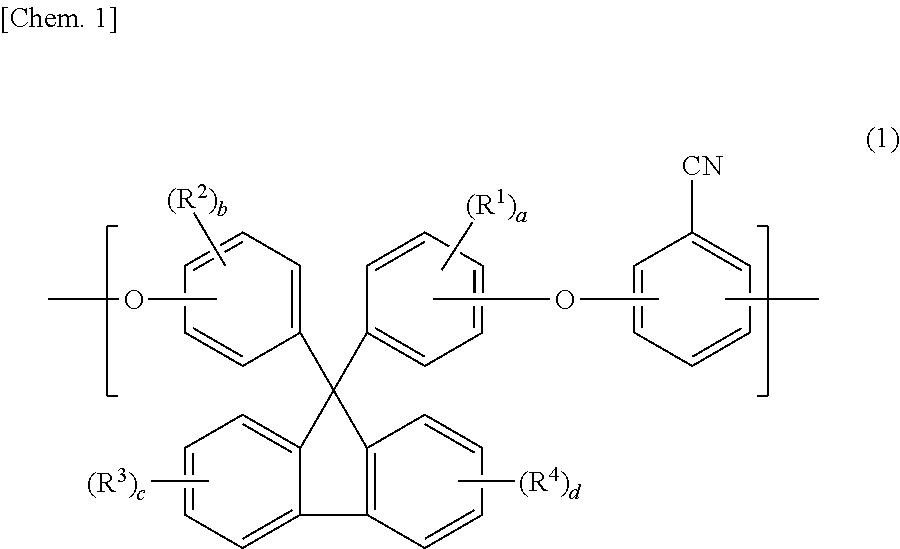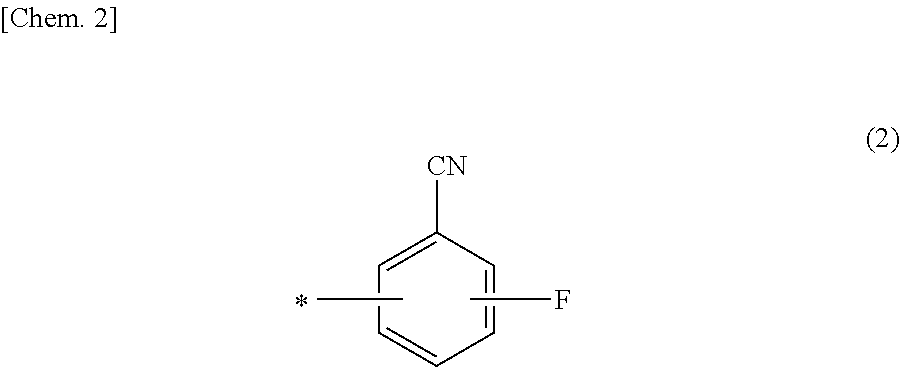Film, resin composition and polymer
a resin composition and film technology, applied in the direction of plastic/resin/waxes insulators, polyether coatings, coatings, etc., can solve the problems of difficult use in applications requiring high heat resistance, glass transition temperature, heat resistance, etc., and achieve excellent heat resistance and light transmission properties, low coloration
- Summary
- Abstract
- Description
- Claims
- Application Information
AI Technical Summary
Benefits of technology
Problems solved by technology
Method used
Image
Examples
example 1
[0176]A 3 L four-neck flask was charged with Component (A): 2,6-difluorobenzonitrile (DFBN) (70.59 g (0.5075 mol)), Component (B): 9,9-bis(4-hydroxyphenyl)fluorene (BPFL) (175.21 g (0.5000 mol)), potassium carbonate (82.93 g (0.6 mol)), N,N-dimethylacetamide (hereinafter also referred to as a “DMAc”) (983 g) and toluene (496 g). Then, to the four-neck flask, a thermometer, a stirrer, a three-way cock with a nitrogen introducing tube, a Dean-Stark tube and a cooling tube were attached.
[0177]After the flask was purged with nitrogen, the resultant solution was reacted at 140° C. for 3 hours. Water generated was removed as needed through the Dean-Stark tube, and when the generation of water was not recognized, temperature was gradually increased to 160° C., and at this temperature, the reaction was performed for 5 hours.
[0178]After the solution was cooled to room temperature (25° C.), a salt generated was removed using a filter paper. The filtrate was poured into methanol for reprecipit...
example 2
[0185]The same operation was performed as in Example 1 except that the blending amount of 2,6-difluorobenzonitrile was changed to 70.25 g (0.5050 mol). From the result of the measurement by 1H-NMR, 94% of the terminal structure of the polymer was found to be the structure represented by the formula (2). Properties of the resultant polymer and film for evaluation are set forth in Table 1.
example 3
[0186]The same operation was performed as in Example 1 except that the blending amount of 2,6-difluorobenzonitrile was changed to 71.29 g (0.5125 mol). From the result of the measurement by 1H-NMR, 98% of the terminal structure of the polymer was found to be the structure represented by the formula (2). Properties of the resultant polymer and film for evaluation are set forth in Table 1.
PUM
| Property | Measurement | Unit |
|---|---|---|
| Tg | aaaaa | aaaaa |
| transparency test | aaaaa | aaaaa |
| thickness | aaaaa | aaaaa |
Abstract
Description
Claims
Application Information
 Login to View More
Login to View More - R&D
- Intellectual Property
- Life Sciences
- Materials
- Tech Scout
- Unparalleled Data Quality
- Higher Quality Content
- 60% Fewer Hallucinations
Browse by: Latest US Patents, China's latest patents, Technical Efficacy Thesaurus, Application Domain, Technology Topic, Popular Technical Reports.
© 2025 PatSnap. All rights reserved.Legal|Privacy policy|Modern Slavery Act Transparency Statement|Sitemap|About US| Contact US: help@patsnap.com



